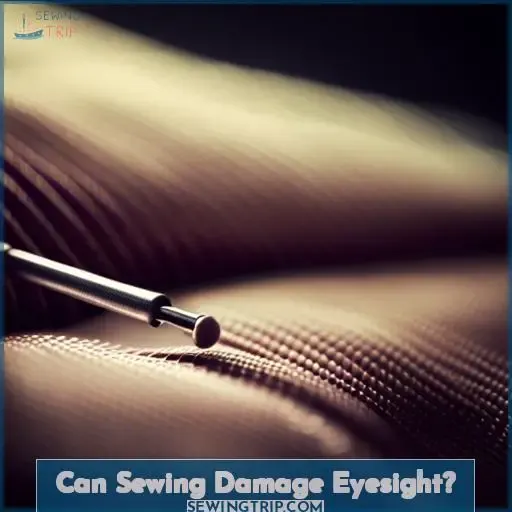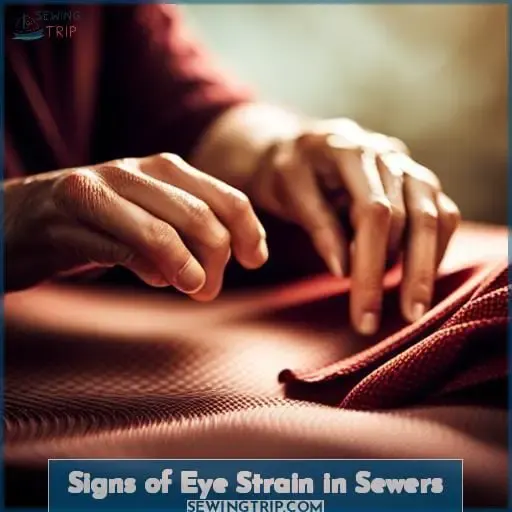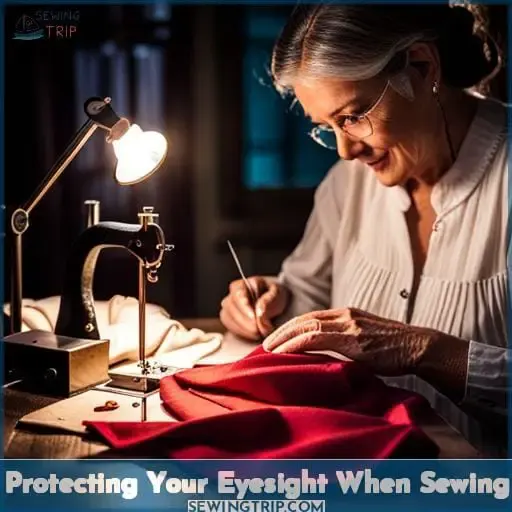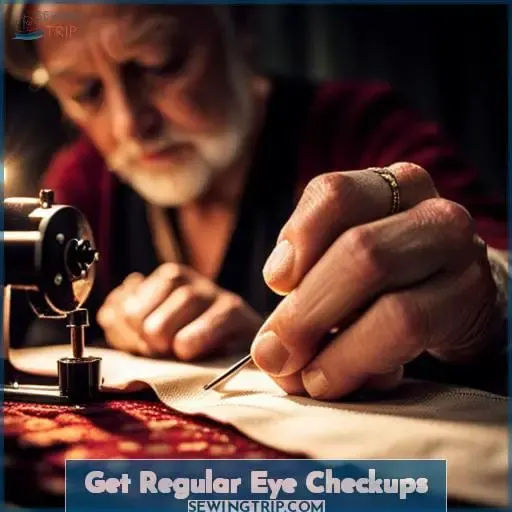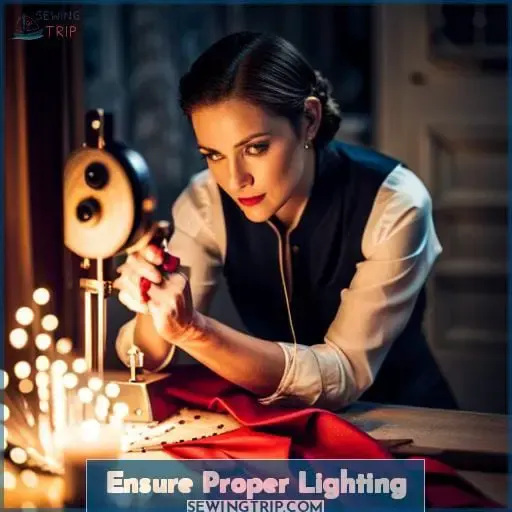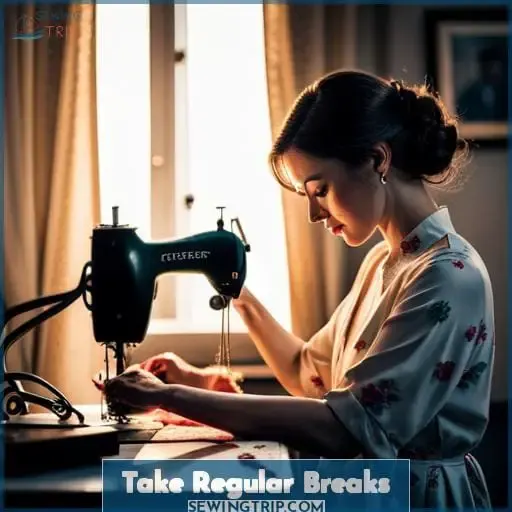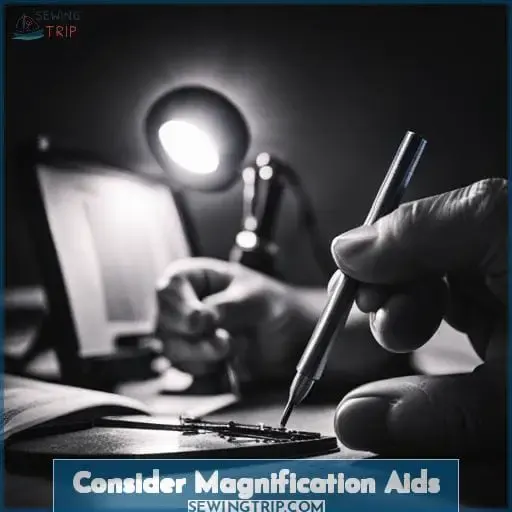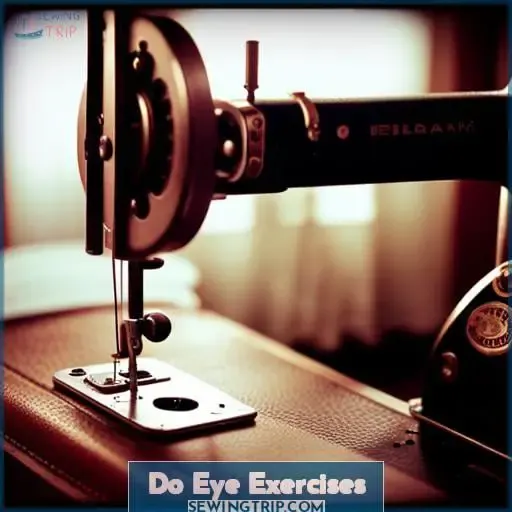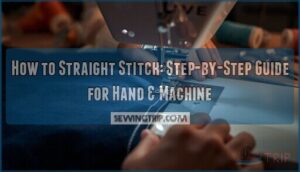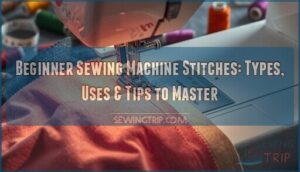This site is supported by our readers. We may earn a commission, at no cost to you, if you purchase through links.
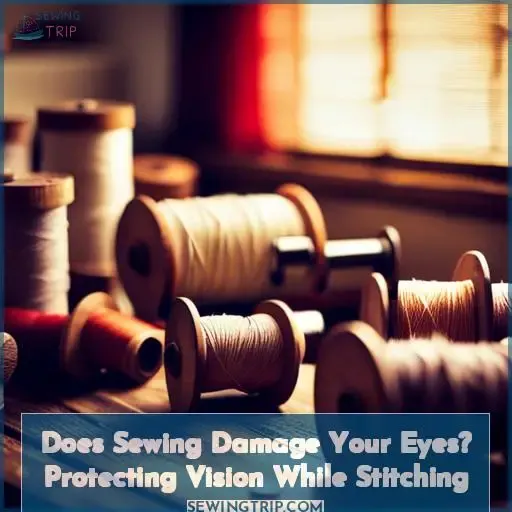
But don’t panic and ditch your hobby just yet—you can take steps to save your vision.
Start with an eye exam to catch issues early.
Ensure adequate lighting in your stitching spot.
Give your eyes regular breaks to reduce fatigue.
And try magnification aids for crisp clarity while you craft.
Follow these tips, and you’ll enjoy stitching for years to come.
Table Of Contents
Key Takeaways
- Frequent headaches, eye fatigue, blurred vision, and difficulty focusing are signs of eye strain from sewing.
- Proper lighting, taking regular breaks, using magnification, and getting eye exams can help protect eyesight.
- Position adjustable lights to prevent glare and choose bulbs that provide bright, daylight-like illumination.
- Devices like magnifying glasses and stand magnifiers make detailed sewing work easier on the eyes.
Can Sewing Damage Eyesight?
You wonder if sewing can harm your vision over time.
While any near work can contribute to eye strain, sewing itself doesn’t damage eyesight when proper prevention strategies are followed.
Monitoring Stitcher’s Vision through regular eye exams allows early detection of changes, enabling prompt Eye Care Tips before permanent issues arise.
Ensuring Optimal Lighting, whether via natural light or artificial light when necessary, also minimizes strain.
Additionally, incorporating 20-20-20 rule breaks gives eyes periodic rest.
Overall, sewing can be part of Hobby Health rather than harm if simple eye health and lighting guidelines are integrated into your routine.
Periodic eye exams coupled with ergonomic sewing setups optimize vision, allowing enjoyment of this craft without concern over sewing eye damage.
Signs of Eye Strain in Sewers
Do you suffer from headaches or blurred vision after long sewing sessions?
These could be signs that your eyes are strained from intense focus on detailed needlework.
Protecting your vision now can prevent more serious eye issues down the road.
Headaches
One sign of eye strain in sewers is frequent headaches after long sewing sessions.
Tension building in the temples and forehead is the body’s warning to improve your sewing ergonomics.
Ensure proper lighting, posture, magnification, and seating to minimize migraine triggers.
Stay hydrated, take regular screen breaks, and consider blue light filtering glasses to protect your vision for sustained sewing.
Blurred Vision
Experiencing blurred vision while sewing signals eye fatigue.
Give your eyes a break by looking into the distance to relax the ciliary muscles.
Choose eye-friendly fabrics and lighting to reduce strain.
Perform simple vision exercises to promote flexibility.
Protecting your sight lets you keep stitching comfortably.
Protecting Your Eyesight When Sewing
Since eye strain is a common issue for sewists, you’ll want to take measures to protect your vision while stitching.
- Ensure proper lighting over your workspace.
- Natural daylight is ideal, but supplement with a gooseneck sewing lamp when needed.
- Position light sources to prevent glare.
- Give eyes a break every 30 minutes.
- Look out a window to relax eyes.
- Consider magnification aids like optivisors to see details without straining.
- Quality optics can make sewing easier on vision.
Get Regular Eye Checkups
You should schedule regular eye exams with your optometrist to monitor any changes in your vision from sewing.
Vision checks every 1-2 years are recommended, with increased frequency after age 40.
This allows early detection of issues like nearsightedness, farsightedness, astigmatism, or age-related vision changes that could impact your ability to see details up close.
An eye doctor can prescribe glasses or contacts specifically for near work like sewing to maximize acuity.
Protecting eye health is crucial for ongoing enjoyment of stitching.
| Age | Recommended Exam Frequency |
|---|---|
| Under 40 | Every 2 years |
| Over 40 | Every 1 year |
Ensure Proper Lighting
You’re going to want proper lighting when sewing to keep your eyes healthy.
Using natural daylight is ideal, but supplement with artificial lighting like a bright table or work lamp when needed, positioning it to avoid glare.
Place your light source to the side to prevent shadows and glare on your work area.
Choose a bright lamp with a daylight or full spectrum bulb to replicate natural light.
If natural light is insufficient, supplement with an artificial light source. Ensure adequate brightness for the task.
Position your light to illuminate your work while avoiding directly facing the light source.
Take Regular Breaks
When you’re stitching for extended periods, it’s crucial to take regular breaks to rest your eyes.
Contracting your eye muscles continuously can fatigue them, so briefly looking into the distance helps them recover.
Aim to pause every 20-30 minutes. Set a timer if needed.
During this break time, look out the window or at something 20 feet away. Close your eyes, breathe deeply, and gently roll your neck and shoulders too.
Taking just 1-2 minutes of self-care helps relaxation.
Stretch breaks bring relief for strained eyes.
Simply pausing to refresh vision makes all the difference.
Brief moments of eye relief let you return renewed.
The keys are knowing when to pause and making vision rest a priority.
Consider Magnification Aids
Magnifiers can help provide clarity when details seem fuzzy.
Combining a magnifier with its own built-in light source is ideal for precision work.
Whatever visual supports stitchers require to continue their craft should be made readily available.
Magnifiers Help Clarity
One magnification aid that can help provide clarity when stitching is a magnifier.
Using a magnifying glass when working on detailed areas makes it easier to see the fabric threads and holes for your needle.
- Handheld magnifying glasses offer portability.
- Illuminated stand magnifiers provide hands-free viewing.
- Try different magnification strengths for your needs.
- Combine with clip-on lights or daylight bulbs.
- Experiment with cheap solutions before investing.
Magnifier & Light Combo
However, you should also consider using a magnification aid that has a built-in light.
This combination provides both enhanced visibility of details and sufficient lighting right where you need it most when stitching intricate designs or working with darker fabrics.
Adjustable stands allow positioning the magnifier and light perfectly.
Portable options keep hands free.
Choosing magnification power appropriately for the task and incorporating task lighting helps protect vision while enjoying your hobby.
Support for Stitchers
You’ll find supportive accessories like stands useful for positioning your magnifier hands-free over stitching.
Ergonomic setups with good posture and proper lighting allow for more vision-friendly stitching environments.
Using creative aids tailored to eye care makes hobbies like stitching gentler on the eyes over time.
Experiment with different friendly tools until discovering what works best for you.
Do Eye Exercises
When stitching for long periods, take brief but frequent breaks to do vision therapy.
Try simple exercises like palming, where you cover your closed eyes with your palms for 30-60 seconds to rest your eyes.
Also practice soft gazing—look into the distance to relax your eye muscles after sustained up-close work.
Palming
You can also try relaxing your eyes through palming, where you cup your hands over your closed eyes to give them a restful break from focusing.
This mindfulness exercise allows the eyes to take a creative break and promotes vision wellness.
Do this relaxing technique for a few minutes whenever your eyes feel strained.
Vision exercises like palming help soothe tired eyes through relaxation and should be part of your regular stitching routine.
Soft Gaze
When doing eye exercises, relax your gaze to avoid straining your eyes further while sewing.
Softly focus your eyes on a point in the distance, allowing the muscles to gently release tension.
This mindful, soft gazing gives your eyes a break from intense concentration.
Experiment with gazing techniques during periodic breaks to find what provides the most visual relaxation for you.
Over time, these focus techniques may translate to optimal distance viewing and mindful stitching habits that protect your vision.
Frequently Asked Questions (FAQs)
What sewing techniques are easiest on the eyes?
Choose loose fabric with larger holes that enhance visibility.
Position work close enough to see details without straining.
Take regular breaks to rest eyes.
Visit an optometrist to address individual needs.
Protecting vision enables safe continuation of enjoyable activities.
Do I need special lighting or lamps for sewing?
Yes, proper lighting helps reduce eye strain when sewing.
Position a bright light closely over your shoulder to clearly illuminate your work area.
Softly focus eyes on your work rather than intensely staring to further ease strain.
Take regular breaks to rest eyes.
How do I know if my eye strain is serious enough to see a doctor?
See an eye doctor if you experience:
- Persistent eye pain
- Blurred vision
- Redness
- Light sensitivity
- Frequent headaches after stitching
These can indicate a serious issue.
Getting a comprehensive eye exam can:
- Identify any underlying conditions
- Provide helpful solutions to protect your vision long-term
Are there any vitamins, supplements, or eye drops that can help with eye fatigue?
Unfortunately, there’s limited evidence that vitamins, supplements, or eye drops can significantly relieve eye fatigue.
While anecdotal reports may claim benefits, more research is still needed to fully understand their effects.
The best approach is to practice good eye care habits:
- Take regular breaks.
- Use proper lighting.
- Get routine eye exams.
- Avoid eye strain triggers.
If symptoms persist, consult an optometrist.
Will getting reading glasses help me sew better if I don’t normally wear glasses?
Yes, getting reading glasses can help improve your vision for sewing if you don’t normally wear glasses.
They make small details easier to see by magnifying and sharpening your vision.
However, be sure to get the right prescription specifically for your sewing distance.
An optometrist can advise on the ideal strength.
Conclusion
Though stitching brings joy, hunched over fabrics strains eyes over time.
But take heart!
With checkups catching issues early, proper lighting ensuring clarity, breaks reducing fatigue, and magnification aids boosting accuracy, you need not abandon your craft.
Follow these visual tips, incorporate scheduled rests, and keep that keyword—eyesight—in mind, and you can stitch on for years to come.

